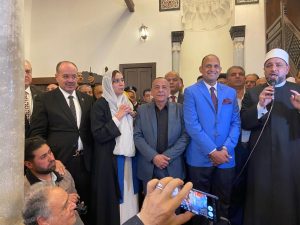The Al-Mahalli Mosque in Rosetta, which dates from the Ottoman period, can now be seen in its former glory after a 16-year restoration project.
The Supreme Council of Antiquities (SCA) and the Ministry of Wakfs (religious endowments) supported the LE105 million project, which was carried out under the close supervision of the SCA.
SCA chief Mostafa Waziry described the town of Rosetta as an “open-air museum, boasting of numerous Islamic monuments that make it the second most important Islamic heritage site after Cairo”.
Situated on the western bank of the Nile River, 65 kilometers northeast of Alexandria, Rosetta—also known as Rashid— is a historical gem in Beheira Governorate. The town became famous for the discovery of Rosetta Stone in 1799. This large fragment of black basalt is the key to the decipherment of the ancient Egyptian hieroglyphs.
Built in 1721, the Al-Mahalli Mosque stands on an area of 2300 square metres making it the second largest in Beheira after the Zaghloul Mosque.

After initially commencing in 2008, Waziry said, the restoration project for the mosque experienced a temporary halt in 2011 as a result of the January events. However, it was subsequently reinitiated in 2017.
He expressed his joy that the re-opening of the mosque coincides with the beginning of Ramadan on March 11 so the townsfolk of Rosetta will have a new and beautiful place to worship during this holy month.
The Al-Mahalli Mosque is in a distinctive architectural style, featuring four main entrances and a traditional layout of porticos and a courtyard. Notably, it boasts two facades — one facing east and the other facing south. The east facade comprises three doors and a brass window of the sabil, a charitable water fountain. The sabil room houses an elegant marble basin.
The mosque has a wooden ceiling. The shrine is in the centre of the qibla portico, which is the wall that faces Mecca. The shrine is a square chamber with doors on the north and south sides. The doors have stone decorations and curved arches. The sides of the shrine have fabric and plaster decorations. The maqsura tomb is made of wood.
The mosque is named after Ali Al-Mahalli, a prominent scholar who died in Rosetta in 1495.
Hisham Samir, who is assistant to the Minister of Tourism and Antiquities for Archaeological Projects, said items of archaeological importance were carefully restored and documented. The marble flooring was relaid and the woodwork on the shrine was repaired, while the minaret and pillars were dismantled and re-erected.
The groundwater level and dug wells was lowered, and a new ablution area and toilets were built. The gypsum decorations, the mihrab and wooden ceilings were subject to extensive repair.
Rosetta has a rich history as a major port used by the ancient Egyptians, Greeks, Romans and Arabs.
The old town of Rosetta preserves its distinctive architecture and narrow alleys, where visitors can enjoy the charm of the district and discover local crafts, fabrics and spices in the lively market.






Discussion about this post